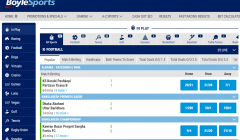What Does Each Way Mean in Betting?
Discover what does each way mean in betting if you need to know. Get the lowdown on this very popular wager, including how it works and when is the best time to use it.
How Does Each Way Betting Work?
An each way bet is most commonly associated with the sport of horse racing and sees you wager on both an outright win and the selection running into a place. Your unit stake is double that of a single to cover both elements. Odds for a place are a fraction of the outright win price.
Ideally, you’ll be able to make a profit just from your pick finishing placed but the maximum payout is available if you back a winner as both aspects of the wager give a return. Sometimes abbreviated to EW betting and also written E/W bet, you’ll see all three used interchangeably.
What Does Each Way Mean In Horse Racing?

When posed the question what does each way mean in betting on horses, the answer is slightly different than with other sports that online betting sites have subsequently adopted it for. Any wager of this type is only possible because of its introduction to the industry through horse racing.
That legacy remains to this very day. The number of runners taking part and the type of race in question determine what fraction of outright win odds pay for a place, as well as how many. We’ll get to the industry standard terms shortly. First of all, it’s good for you to know the fraction available will either be a quarter or a fifth of fixed horse racing betting odds in the UK.
In the event of non-runners, it’s also possible that each way terms will be revised by the bookies. This is perfectly legal and to ensure fairness for all. The bookmakers will have to refund many bets on the withdrawn horse and, if its absence takes the size of the field below the minimum threshold for certain terms to be offered, that is unfortunate but the customary rule.
If you’ve been wagering each way on the horses in advance in the ante post betting markets, then bookies must honour the terms on which that bet was struck. That’s a subtle difference in the rules governing their behaviour, but an important distinction that you should remember.
Place Terms Explained
If there aren’t at least five runners in a horse race, then you can forget getting an EW bet on that event. Should there be more than four but fewer than eight runners, then second place pays. With eight or more entrants, you’ll get a minimum of three places depending on the type of race.
Conditions races with that many runners are a fifth of outright win odds, but handicaps pay a better fraction at a quarter. The table below contains all the information from Tattersalls Committee Rules on Betting with Rule 3 governing standard practice for both on and off-course bookies offering each way markets:
| Number of Runners | Place Terms | Notes |
| 1, 2, 3 or 4 | None, win only bets | Standard industry practice |
| 5, 6 or 7 | 1/4 for 2 places | Extra Places at bookies’ discretion |
| 8 or more in conditions races | 1/5 for 3 places | Extra Places at bookies’ discretion |
| 12-15 in handicap races | 1/4 for 3 places | Extra Places at bookies’ discretion |
| 16 or more in handicap races | 1/4 for 4 places | Extra Places at bookies’ discretion |
| Additional places | 1/5 for 5, 6 places, etc | Available at bookies’ discretion |
What Does Each Way Mean in Betting on Football
There are also some each way options on the beautiful game, but it’s nothing like as pervasive as the horses. With certain outright football betting markets on competitions, leagues and tournaments, you’ll find this is available especially in pre-season before a ball has been kicked. One great example is the top goalscorer market.
In this particular case, the answer to what does each way mean in football betting is a quarter of outright odds available on four places early on. As the season progresses, the terms offered may be reduced to three or even two places, especially if there’s a runaway leader in the goal charts.
When betting on the winner of a football cup competition or tournament outright, you may also find E/W betting markets available. The terms offered are often just half the odds for two places. That second place means to reach the final. You’ll receive a payout regardless of whether the team wins, but the size of it depends on their performance in the last game.
To summarise the major difference between what does each way mean in betting on football and horse racing, it’s a question of time involved. While the latter keeps your interest for just one race whenever that might be, placing such a wager on the other popular gambling sport gives you a reason to watch throughout the entire competition.
Why Should I Bet Each Way?
The case for EW betting is very simple. It mitigates some of the potential lose attached to just backing outcomes to win. If you could receive a return, and better yet a profit, if you wager comes second, then that’s a very good thing. Betting is often about little victories as punters battle the bookies in an eternal struggle between those who offer odds and others who take them.
Extra incentive, especially with horse racing, isn’t too difficult to find nowadays either. That’s because the bookies often pay additional places on feature events and big betting races. While they don’t make it easy for you by choosing the trickiest handicaps, if fourth or fifth place pays out, any each way fancies should come under serious consideration.
While there’s a greater outlay on bets with the unit stake doubling, that’s often a gamble worth taking when balancing the benefits. Betting E/W can’t totally reduce the risks of losing as if your selection doesn’t finish placed, then your wager loses, but there is a lot of upside to this approach to gambling.
When is it Best to Bet Each Way?
There’s a time and place for placing an EW bet, so when is it? You need to break even if the selection is placed in order to make if worthwhile. That means there are minimum odds thresholds that apply to your bets, depending on the fraction offered.
If that’s a quarter, then anything shorter than 4/1 (5.00) doesn’t make sense to back each way. In the event the place terms specify a fifth, then that goes up to a minimum price of 5/1 (6.00). Taking shorter odds will still yield a return, but you’ll end up losing money overall.
The more places you can get on your each way bet, the better. You should take advantage of Extra Place races as the horse you fancy can end up finishing fifth or sixth and still get something back from the wager. These favourable terms are most commonly available on big field handicaps like the Grand National over jumps, or the Cesarewitch on the Flat.
Although the more runners involved, then the more difficult it is to find placed horses, the bookies recognise the challenge and provide payouts on additional finishing positions. Giving yourself the best statistical chance of a horse being placed, whatever their implied probability may be, is the name of the game.
Mistakes to Avoid with Each Way Betting
After figuring out what does each way mean in betting terms, there are still potential pitfalls. One or two of these are out of your hands to some extent as they depend on external factors, but it’s good to be aware of the don’ts as well as the dos and best practice:
- Small field races – It only takes one or two non-runners and bets each way are no longer offered. A field of six can become four easily if conditions change following final declarations.
- Not breaking even – If you can’t break even from an each way wager, then there’s no value betting at all really and that kind of defeats the object. You should aim for the bear minimum of getting your total outlay back from a selection finishing placed.
- Terms & conditions – Should there be non-runners, then not only is there prospect of a Rule 4 deduction reducing what you could win by so many pence in the pound (£) but each way terms could be reduced. This even applies to Extra Place races. Keep an eye on the minimum runners needed for the terms the bet was struck at to be honoured by bookies.
Which Bookies are Best for Betting Each Way?
Any bookmaker that goes in for fixed odds horse racing has to offer E/W betting options to you. These are five of the leading sites for this type of wagering, because they commonly offer lots of Extra Place races:
Bet £10 Get £50 in Bonuses
Bet £10 Get £50 in Bonuses
- BOG applies after 8am on race days
- Includes selected international races
- Available for horse racing & greyhounds
Bet £10 & Get £30 in Free Bets for new customers at bet365
Bet £10 & Get £30 in Free Bets for new customers at bet365
- All feature races eligible
- Applies to win and each-way bets
- Available to new and existing customers
Bet £10 Get £25 In Free Bets
Bet £10 Get £25 In Free Bets
- Combined odds of just 3/1 required to qualify for acca insurance offers
- Generous welcome offer
- Daily specials available
Bet £10, Get £30 In Free Bets +
Bet £10, Get £30 In Free Bets +
- Bet Builder, BetFeed & BetFinder tools
- Large number of in-play football markets
- Live football streaming available
Bet £10 Get £30 In Free Bets
Bet £10 Get £30 In Free Bets
- Enhanced ACCAs & Wincasts
- Daily Free Bet Offers
- Safe & Secure UK betting site



























